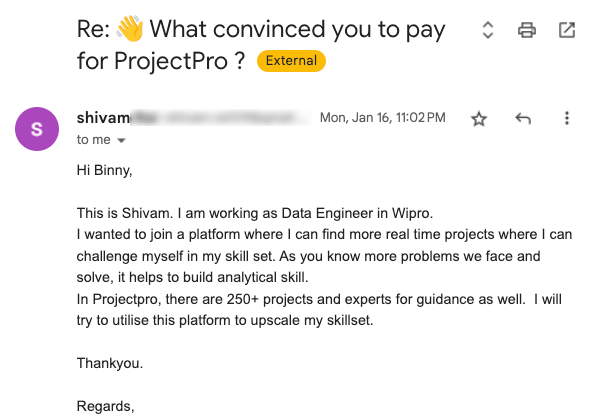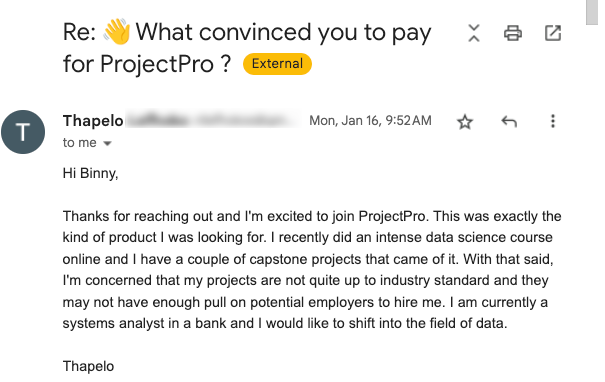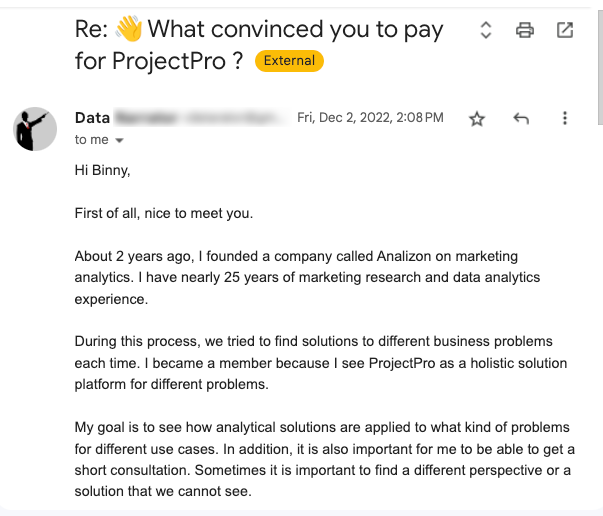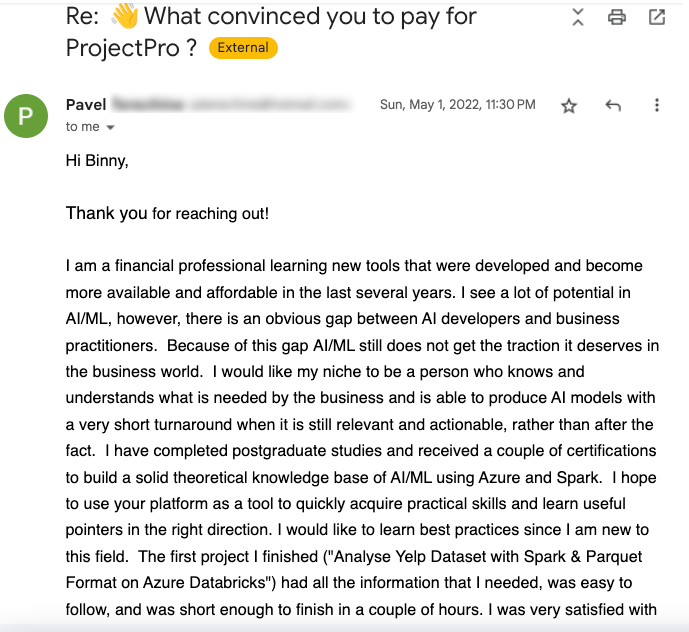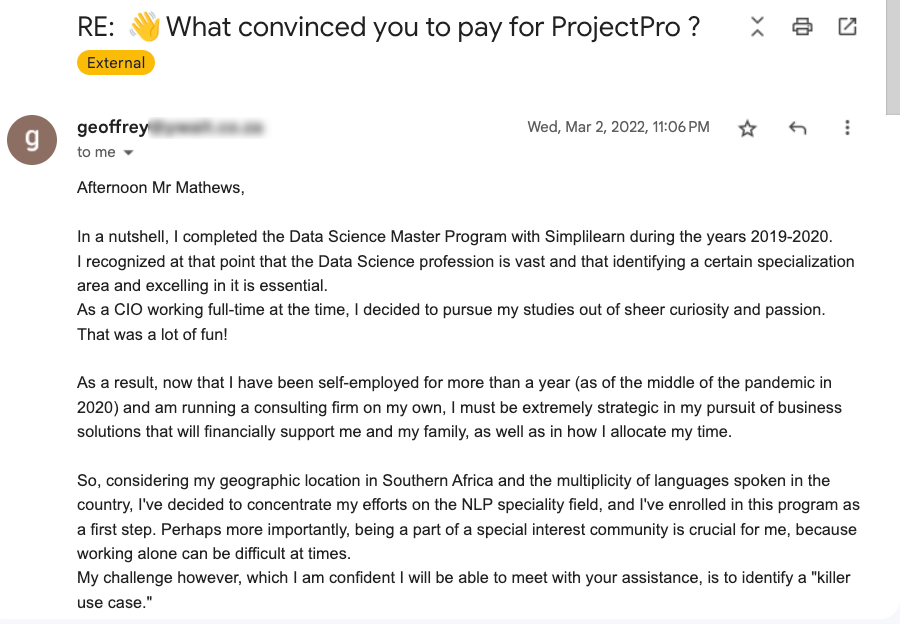
Data Scientist, Credit Suisse

Data Engineer - Capacity Supply Chain and Provisioning, Microsoft India CoE

NLP Engineer, Speechkit

Principal Data Scientist - Cyber Security Risk Management, Verizon
In this Predictive Analytics Project, you will build a model to accurately forecast the timing of customer and supplier payments for optimizing working capital.
Get started today
Request for free demo with us.
Schedule 60-minute live interactive 1-to-1 video sessions with experts.
Unlimited number of sessions with no extra charges. Yes, unlimited!
Give us 72 hours prior notice with a problem statement so we can match you to the right expert.
Schedule recurring sessions, once a week or bi-weekly, or monthly.
If you find a favorite expert, schedule all future sessions with them.
Source: ![]()
Source: ![]()
Source: ![]()
Source: ![]()
Source: ![]()
Source: ![]()
Source: ![]()
Source: ![]()
Source: ![]()
Source: ![]()
Source: ![]()
Source: ![]()
Source: ![]()
250+ end-to-end project solutions
Each project solves a real business problem from start to finish. These projects cover the domains of Data Science, Machine Learning, Data Engineering, Big Data and Cloud.
15 new projects added every month
New projects every month to help you stay updated in the latest tools and tactics.
500,000 lines of code
Each project comes with verified and tested solutions including code, queries, configuration files, and scripts. Download and reuse them.
600+ hours of videos
Each project solves a real business problem from start to finish. These projects cover the domains of Data Science, Machine Learning, Data Engineering, Big Data and Cloud.
Cloud Lab Workspace
New projects every month to help you stay updated in the latest tools and tactics.
Unlimited 1:1 sessions
Each project comes with verified and tested solutions including code, queries, configuration files, and scripts. Download and reuse them.
Technical Support
Chat with our technical experts to solve any issues you face while building your projects.
7 Days risk-free trial
We offer an unconditional 7-day money-back guarantee. Use the product for 7 days and if you don't like it we will make a 100% full refund. No terms or conditions.
Payment Options
0% interest monthly payment schemes available for all countries.
Overview
Working capital optimization involves strategically managing a company's current assets and liabilities to enhance operational efficiency and financial health. It focuses on finding the right balance between accounts receivable (AR) and accounts payable (AP) to ensure sufficient liquidity while minimizing costs and risks.
AR data refers to money customers owe the company, while AP data represents the money the company owes to suppliers.
This involves predicting the timing of customer payments and supplier payments to ensure cash flow and liquidity in a specific period for the company. By analyzing historical data and using predictive modeling techniques, the project aims to forecast the week customers are likely to pay the company and the week in which the company should pay suppliers.
These predictions enable the company to proactively manage cash flow, ensuring that customer payments are received on time to cover outgoing payments to suppliers. This helps maintain a healthy cash position, enhances liquidity, and allows the company to meet its financial obligations effectively.
Aim
The project aims to optimize working capital management by leveraging accounts receivable and payable data. Through predictive analysis, the project aims to accurately forecast the timing of customer and supplier payments, enabling the company to ensure cash flow and liquidity within a specified period.
Note: The videos - Setting up MS SQL Server Database on AWS RDS with Excel Files and How to Restore Data from a Backup File on AWS RDS respectively cover setting up the database on AWS.
Data Description
Customer Data:
Customer ID: Unique identifier for each customer.
Customer Name: Name of the customer.
Customer Payment Terms: Terms and conditions for customer payments.
Address: Physical address or location of the customer.
Credit Limit: Maximum credit amount extended to the customer.
Receivables Data:
Business Code: Code representing the type of business transaction.
Customer Number: Unique identifier for each customer.
Customer Name: Name of the customer.
Payment_Date: Date of payment received.
Business Year: Year of the business transaction.
Posting_Date: Date of posting the transaction.
Due_Date: Date by which the payment is due.
Payterm: Payment terms for the invoice.
Invoice Currency: Currency in which the invoice is issued.
Total Open Amount: Total amount of the invoice.
USD_CURRENCY: Currency conversion rate to USD.
Total Open Amount_USD: Total amount in USD.
Invoice ID: Unique identifier for each invoice.
Is Open: Indicates whether the invoice is open or closed.
DUNNLEVEL: Dunn level of the invoice. Dunn level refers to the level of past-due status or aging of an invoice, indicating the severity or length of time the invoice remains unpaid, basically how many times the customer was contacted for payment and the status remained unchanged.
Credit_limit: Credit limit assigned to the customer.
Baseline_Date: Baseline date for the transaction.
Region: Geographic region associated with the transaction.
Suppliers Data:
Supplier ID: Unique identifier for each supplier.
Supplier Name: Name of the supplier.
Payment Terms: Terms and conditions for supplier payments.
Vendor Type: Type or category of the vendor/supplier.
Supplier Category: Categorization of the supplier.
Payables Data:
Invoice Number: Unique identifier for each invoice.
Posting Date: Date of posting the invoice.
Invoice Date: Date of the invoice.
Payment Date: Date of payment made.
Net Due Date (System Calculated Date): Calculated date for net payment due.
Supplier ID: Unique identifier for each supplier.
Invoice Amount: Total amount of the invoice.
Fiscal Year: Financial year associated with the invoice.
Overdue: Indicates if the payment is overdue.
Invoice Status: Status of the invoice (e.g., paid, outstanding).
Spend Category: Categorization of the expenditure.
Total Outstanding Amount: Total amount outstanding for the invoice.
Late Payment Fees: Fees charged for late payments.
Payterm_n: Payment terms for the invoice.
Vendor Type: Type or category of the vendor/supplier.
Tech Stack
Language: Python
Libraries: pandas, numpy, matplotlib, statsmodels, seaborn, scikit-learn, pyodbc
Approach
AR Data:
Exploratory Data Analysis (EDA): Analyze the accounts receivable data to gain insights into the distribution, trends, and patterns.
Feature Engineering: Transform and manipulate the AR data to extract relevant features for the prediction model.
Model Building: Utilize various regression models such as RandomForestRegressor, LinearRegression, KNeighborsRegressor, GradientBoostingRegressor, and SVR to predict the week of customer payments.
AP Data:
EDA: Perform exploratory analysis on the accounts payable data to understand its characteristics and identify any anomalies.
Feature Engineering: Engineer additional features from the AP data that may be relevant for the analysis and prediction.
Model Building: Develop prediction models based on the AP data to forecast the week of supplier payments.
Working Capital Optimization (WCO) Calculations:
Group and sum the receivables and payables data on a weekly basis.
Calculate the working capital by subtracting the sum of payables from the sum of receivables for each week.
Analyze the working capital figures to identify periods of positive or negative cash flow and assess the overall liquidity.
Recommended
Projects
7 Popular Azure ETL Tools for Data Engineers in 2024
Explore the top seven Azure ETL tools reshaping the landscape in 2024. Revolutionize your data workflows with these robust solutions. | ProjectPro
Learning Optimizers in Deep Learning Made Simple
Understand the basics of optimizers in deep learning for building efficient algorithms.
Data Science vs Data Engineering:Choosing Your Career Path
Data Science vs Data Engineering-Learn key differences, and career tips to seamlessly transition from data engineer to data scientist with ProjectPro
Get a free demo







